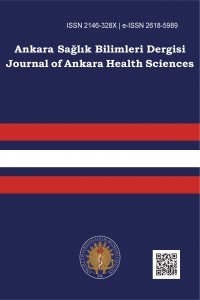Hemşirelik Öğrencilerinin Bakım Odaklı Uygulamalarının Hemşire-Hasta Etkileşimine Etkisi
Davranış, hasta odaklı hemşirelik, hemşirelik bakımı, hemşirelik eğitimi, tutum
The Effect of Nursing Students’ Caring Oriented Practices on Nurse-Patient Interactions
Behavior, patient-centered nursing, nursing care, nursing education, attitude,
___
- Alemu, S., Jira, C., Asseffa, T., & Desa, M. M. (2014). Changes in inpatient satisfaction with nursing care and communication at Debre Markos Hospital, Amhara Region, Ethiopia. American Journal of Health Research, 2(4), 171-176. https://doi.org/10.11648/j.ajhr.20140204.21
- Allande-Cussó, R., Gómez-Salgado, J., Macías-Seda, J., & Porcel-Gálvez, A. M. (2021). Assessment of the nurse-patient interaction competence in undergraduate nursing students. Nurse Education Today, 96(October 2020). https://doi.org/10.1016/j.nedt.2020.104627
- Atar, N. Y., & Aştı, T. A. (2012). Bakım odaklı hemşire-hasta etkileşimi ölçeğinin güvenilirlik ve geçerliği. Florence Nightingale Hemşirelik Dergisi, 20(2), 129–139. https://doi.org/10.17672/fnhd.96696
- Baykara, Z. G. (2014). Hemşirelik bakımı kavramı. Türkiye Biyoetik Dergisi, 1(2), 92–99.
- Bayraktar, D., & Eşer, İ. (2017). Hemşirelerin bakım odaklı hemşire-hasta etkileşimine yönelik tutum ve davranışları. Anadolu Hemşirelik ve Sağlık Bilimleri Dergisi, 20(3), 188–194. https://doi.org/10.17049/ahsbd.57390
- Chung, H. C., Hsieh, T. C., Chen, Y. C., Chang, S. C., & Hsu, W. L. (2018). Cross-cultural adaptation and validation of the Chinese Comfort, Afford, Respect, and Expect scale of caring nurse–patient interaction competence. Journal of Clinical Nursing, 27(17–18), 3287–3297. https://doi.org/10.1111/jocn.14196
- Cossette, S., Cara, C., Ricard, N., & Pepin, J. (2005). Assessing nurse-patient interactions from a caring perspective: Report of the development and preliminary psychometric testing of the Caring Nurse-Patient Interactions Scale. International Journal of Nursing Studies, 42(6), 673–686. https://doi.org/10.1016/j.ijnurstu.2004.10.004
- Demir, S. (2017). Hildegard E. Peplau: Kişilerarası ilişkiler teorisi. İçinde A. Karadağ, N. Çalışkan, & Z. Göçmen Baykara (Ed.), Hemşirelik Teorileri ve Modelleri (1. baskı, ss. 122–144). Akademi Basın ve Yayıncılık.
- Eren, H., & Sonay Turkmen, A. (2020). The relation between nursing students’ levels of self-efficacy and caring nurse–patient interaction: a descriptive study. Contemporary Nurse, 56(2), 185–198. https://doi.org/10.1080/10376178.2020.1782763
- Erigüç, G., Şener, T., & Eriş, H. (2013). İletişim becerilerinin değerlendirilmesi: Bir meslek yüksekokulu öğrencileri örneği. Hacettepe Sağlık İdaresi Dergisi, 16(1), 45–65. https://dergipark.org.tr/en/download/article-file/84736
- Erzincanlı, S., & Yüksel, A. (2018). Öğrenci hemşirelerin bakım odaklı hemşire-hasta etkileşimine yönelik tutum ve davranışlarının bazı değişkenler açısından incelenmesi. Anadolu Hemşirelik ve Sağlık Bilimleri Dergisi, 21(1), 10–17. https://dergipark.org.tr/en/download/article-file/464994
- Kaçmaz, E. D., & Çam, M. O. (2019). Review of caring nurse-patient interaction for nurses caring for psychiatric patients. Journal of Psychiatric Nursing, 10(1), 65–74. https://doi.org/10.14744/phd.2018.83702
- Kahraman, H., & Ceyhan, O. (2022). Öğrenci gözünden:hemşireliğin bakım verici rolü. Ordu Üniversitesi Hemşirelik Çalışmaları Dergisi. 5(1), 60-66. https://doi.org/10.38108/ouhcd.897896
- Kalender, N., Tosun, N., Çınar, F. İ., Bağçivan, G., & Yaşar, Z. (2016). Hemşirelik yüksekokulu öğrencilerinin bakım odaklı hemşire-hasta etkileşimine yönelik tutum ve davranışlarının değerlendirilmesi. Gülhane Tıp Dergisi, 277–281. https://doi.org/10.5455/G
- Lechleitner, R. (2019). A study to assess home health nurses from a carative perspective. Hospital Topics, 97(1), 11–14. https://doi.org/10.1080/00185868.2018.1551735
- Ortabag, T., Tosun, N., Bebi, H., Yava, A., & Çiçek, H. S. (2010). Yatağın diğer tarafı : Hemşirelik Yüksek Okulu birinci sınıf öğrencilerinin eğitim amaçlı hastaneye yatma deneyimleri. Gülhane Tıp Dergisi, 52, 189–197. https://cms.galenos.com.tr/Uploads/Article_33435/GMJ-52-189-En.pdf
- Öz, F. (2010). Hemşirelik. İçinde Sağlık alanında temel kavramlar (2. baskı, ss. 37–40). Mattek Matbaacılık Bas. Yay. Tic. Ltd.
- Pfaff, K., Baxter, P., Jack, S., & Ploeg, J. (2014). An integrative review of the factors influencing new graduate nurse engagement in interprofessional collaboration. Journal of Advanced Nursing, 70(1), 4–20. https://doi.org/10.1111/jan.12195
- Starmer, A. J., O’Toole, J. K., Rosenbluth, G., Calaman, S., Balmer, D., West, D. C., Bale, J. F., Jr, Yu, C. E., Noble, E. L., Tse, L. L., Srivastava, R., Landrigan, C. P., Sectish, T. C., Spector, N. D., & I-PASS Study Education Executive Committee. (2014). Development, implementation, and dissemination of the I-PASS handoff curriculum: a multisite educational intervention to improve patient handoffs. Academic Medicine, 89(6), 876-884. https://doi.org/10.1097/ACM.0000000000000264
- Tan, M., & Polat, H. (2020). Hemşirelik öğrencilerinin bakım odaklı hemşire-hasta etkileşimine yönelik tutum ve davranışlarının belirlenmesi. Acıbadem Üniversitesi Sağlık Bilimleri Dergisi, 11(3), 451–457. https://doi.org/10.31067/0.2020.294
- Taşcı, S. (2005). Hemşirelikte problem çözme süreci. Sağlık Bilimleri Dergisi, 14(Hemirelik Özel Sayısı), 73–78. http://sagens.erciyes.edu.tr/dergi/hemsire/Sultan2.pdf?ref=carstuning.biz
- Uzelli Yilmaz, D., Akın Korhan, E., & Khorshid, L. (2017). Evulation of nursing care quality in a palliative care clinic
Bir palyatif bakım kliniğinde hemşirelik bakım kalitesinin değerlendirilmesi. Journal of Human Sciences, 14(3), 2968. https://doi.org/10.14687/jhs.v14i3.4828
- Vujanić, J., Mikšić, Š., Barać, I., Včev, A., & Lovrić, R. (2022). Patients’ and nurses’ perceptions of ıimportance of caring nurse–patient interactions: Do they differ? Healthcare (Switzerland), 10(3), 1–16. https://doi.org/10.3390/healthcare10030554
- Yalçın, N., & Aştı, T. (2011). Hemşire-hasta etkileşimi. Florence Nightingale Hemşirelik Dergisi, 19(1), 54–59. https://dergipark.org.tr/en/download/article-file/95055
- Yılmaz, D., & Gökdere Çinar, H. (2017). Hemşirelik bölümü son sınıf öğrencilerinin bakım odaklı hemşire-hasta etkileşimine yönelik tutumlarının incelenmesi. Journal of Human Sciences, 14(4), 3300. https://doi.org/10.14687/jhs.v14i4.4911
- Zaybak, A., İsmailoğlu, E. G., & Eftelli, E. (2014). Nursing students attitudes and behaviors towards caring nurse-patient interaction. International Refereed Journal of Nursing Researches, 1(2), 24–37. https://doi.org/10.17371/uhd.2014210144
- ISSN: 2146-328X
- Yayın Aralığı: Yılda 2 Sayı
- Başlangıç: 2012
- Yayıncı: Ankara Üniversitesi
Ufuk DEMİREL, Hatice TEL AYDIN
Covid-19 Pandemisi Sürecinde Kadınlarda Premenstrual Sendrom ve Psikolojik Değişimler
Havva YEŞİLDERE SAĞLAM, Elif GURSOY, Atike KAYA
Besinlerdeki Bazı Biyoaktif Bileşiklerin Anti-Diyabetik Etkinliği
Ayden ÖZEKİNCİ, İrem OLCAY EMİNSOY
Biyotik Ailesinden Postbiyotiklerin Sınıflandırılması ve Antitümör Aktiviteleri
Babaların Bakış Açısına Göre Çocuğun Teknolojik Araç Kullanımının İncelenmesi
Hemşirelik Öğrencilerinin Bakım Odaklı Uygulamalarının Hemşire-Hasta Etkileşimine Etkisi
Hilal KAHRAMAN, Seda AKUTAY, Özlem CEYHAN
Serebral Palside Dil ve Konuşma Bozukluklarına Yönelik Farkındalık Çalışması
